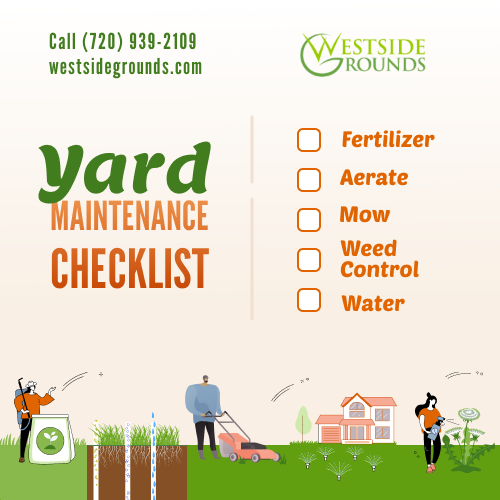Yard Maintenance Checklist

For your lawn, spring should be a time of revitalization and new growth, a time when it begins to wake up from the hibernation of winter and the cold that you face here in Colorado every year. Spring is the time of year when you set your lawn up for a beautiful summer and fall, or for failure, so what you’re doing right now matters.
How, then, can you ensure that your lawn will be beautiful throughout the year? While there is some disagreement over the best practices to get a beautiful lawn, here is a yard maintenance checklist you can use to get ready.
Fertilize Your Lawn
Fertilizing your lawns throughout spring, from March to June, is definitely a good idea if you want a gorgeous lawn under your feet later in the year.
A good fertilizer for your lawn is going to have a lot of nitrogen in it, and this nitrogen will be coming from sources that are both quick and slow to release their yield. This ensures that the lawn keeps receiving nitrogen throughout the process and that you will end up with a lawn well-fertilized.
Aerate Your Lawn
Sometimes called ‘cultivating’ your lawn, aeration is a must. In general, experts recommend that your core holes be two or three inches long. However, so long as your core holes are at least an inch deep, you’re going to be a lot better off than if you didn’t aerate at all.
Why do we aerate? Aeration of the lawn helps with piercing the ‘thatch’ layer, which can make it harder to get water into the roots of your grass.
At the same time that you’re aerating, you can also begin overseeding your grass. This is especially important when you are in the midst of a winter mite issue, or if you’ve been suffering from rain or a drought or something similar.
You should also be fertilizing during this phase, to make sure that the nutrients are being carried to the roots as well.
Mowing The Lawn
You should be mowing your lawn in spring. Set your blades to either about 2 and a half or three inches, and stick with whichever height you’ve chosen for the entire mowing season. Make sure that your blade is sharp so that you are cutting the grass and not shredding it or breaking it.
Finally, when mowing the lawn, be sure to, whenever you can, mow during the cooler morning or the night, instead of noonish. This helps to cut down on turf damage.
Control Your Weed Problem
A lot of sources will suggest preemergent herbicides to thin out the weeds that you may begin experiencing during the growing season. However, if during the spring season, you’re going to be overseeding your lawn, it is not a good time to use such herbicides. Any time you’re going to be using preemergent herbicides, it’s important that you water the area with about a half an inch of water shortly afterward.
Now, if you cannot use the preemergent herbicides (because you’re overseeding, for example), there are great postemergence herbicides. However, those generally aren’t available for general consumption. So if you’re having issues with crabgrass or other broadleaf weeds, you’re going to want to hire a professional who can help you out with your weeds.
Water Your Lawn
You’re going to want to set your irrigation of your lawn to occur between 6 PM and 10 AM. Make sure that whatever your irrigation system, it is properly set up, and is not dumping water in the street or your driveway or on your house.
Whenever possible, you’re going to want to give your grass about 3/4ths of an inch of water and to do so slowly enough that there is no pooling, puddling, or runoff occurring. If there are places that your irrigation system doesn’t reach, you may have to water them by hand to make sure that you don’t end up with brown spots. Be sure to look into local watering rules as well.
Don’t Stress About Lawn Care—We’ve Got You Covered!
These are just general steps you can take to make sure your lawn will look great and that you will be getting it off to a good start. For more information, contact a local lawn care expert.
